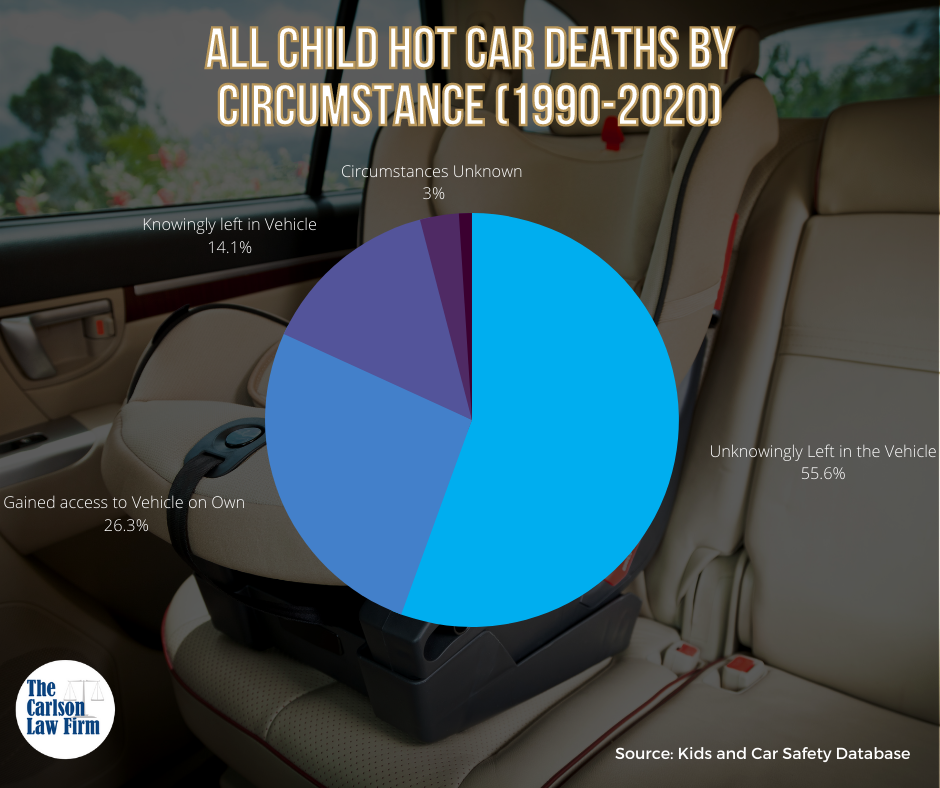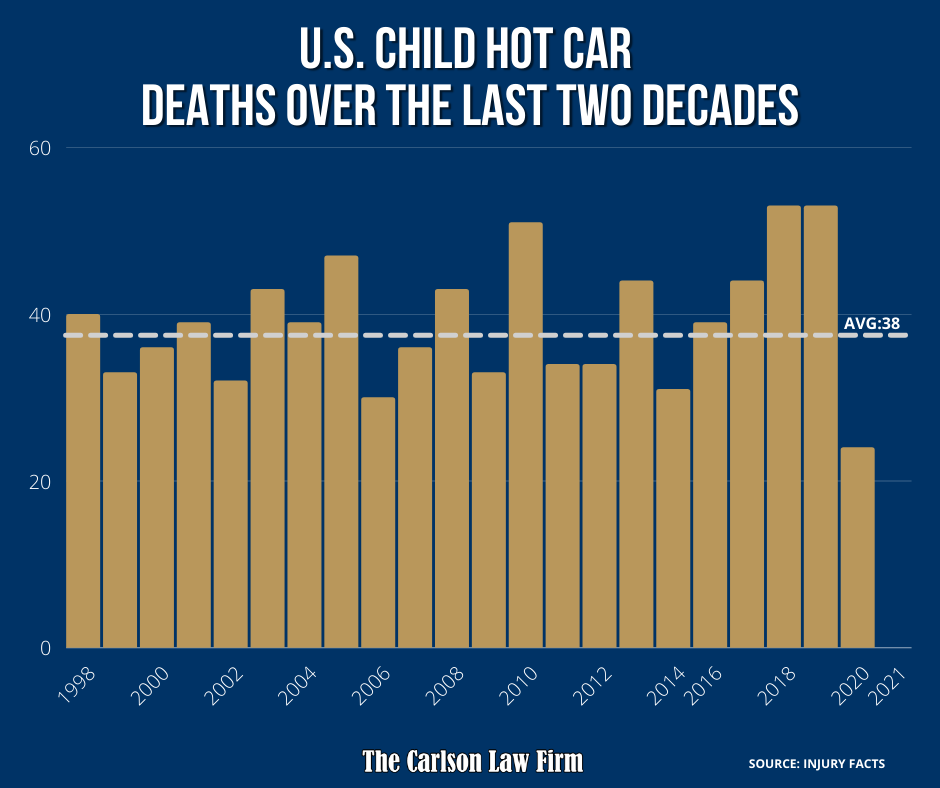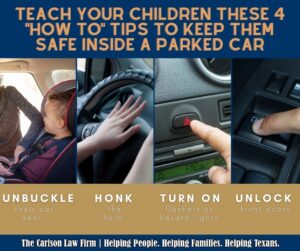Because of the number of times you’ve gotten behind the wheel of a car and…
While Forgotten Baby Syndrome can occur any time of year, it is particularly deadly from April to September every year. On a warm spring or summer day, a car can heat to dangerous temperatures in as little as ten minutes. Death by hyperthermia is the official medical designation of hot car deaths when it happens to young children.
Young children, the elderly, and disabled individuals left alone in a vehicle are at higher risks of suffering from heatstroke in parked vehicles. Since 1990, 1,050 children have died as a result of heat strokes in hot cars. The clinical definition of heatstroke is when a person’s body temperature exceeds 104 degrees. An unfortunate statistic is that every year an average of 39 children die from being accidentally left, intentionally left, or gaining unsupervised access to a vehicle. In addition to a child’s inability to escape safety restraints or unlock car doors, children’s bodies overheat three to five times faster than adults. Further, hot cars are the primary non-crash vehicle-related cause of death in children under 14.
What is Forgotten Baby Syndrome?
Forgotten Baby Syndrome refers to what happens when parents accidentally leave a baby or young child in a locked car, and it often has tragic results. It is the medical explanation that describes how a parent can walk away from the car without thinking about their child in the backseat. Forgotten Baby Syndrome often occurs when parents focus on future tasks instead of the moment. This mindset can be extremely dangerous for a quiet or sleeping baby.
There is no consistent character profile of the parent who forgets his or her child in the car. Forgotten Baby Syndrome affects parents across race, gender, income and education levels, and personality temperaments. Forgetting a child in the car occurs most often when a parent has a change in routine or is absent-mindedly multitasking while the child is in the car.
In many Forgotten Baby Syndrome cases, parents that don’t normally take their child to daycare or a babysitter will drive the same route to and from work every day. In these cases, the parent drives the normal route without thinking. Doing a task without thinking is called motor memory. When you do an activity using motor memory, it frees up space in your brain to think about the future tasks at hand. A quiet baby or small child in the backseat could easily be forgotten by a parent who is: A) checked out of the moment and B) focused on the future.
While 56% of hot car deaths occur when loving parents leave children in the car, there are other ways a child can die in a vehicle. In 28 percent of cases, the child gained access to a vehicle without a parent’s knowledge. The best way to avoid a child gaining access to a vehicle is to keep your car keys out of reach.

Can Technology Prevent Forgotten Baby Syndrome?
In April 2021, the Federal Communications Commission granted a waiver allowing equipment manufacturers and automakers to install radar-based technology that detects and alerts to the presence of a child. More sophisticated technology can detect movement as subtle as a baby’s breathing.
One alarm system will allow your vehicle to detect and notify you when a backseat seatbelt is locked. A display will appear on the dash when the car is on, notifying the driver that the seatbelt is locked. When the vehicle comes to a stop, an alarm will go off to advise the driver to check the backseat.
In addition, cell phone providers are also assisting with rear seat safety alarms by allowing drivers to connect a plug-in device into the computer of their vehicles that will mirror an image of their car. If someone has the feature in which their vehicle checks the backseat, the phone will also alert them to check the backseat.
Tesla and other manufacturers have been working on technology that will trigger an alarm when a child is detected alone in a vehicle. This radar technology may be an added safety feature on future vehicles.
Automakers are promising all new vehicles will have rear seat safety alarms by 2025.
Has There Been an Increase in Hot Car Deaths?
While even one child is too many, in 2020 the number of children who died in hot cars was cut in half from the previous year. 2020 marked the first time in six years that there was a decline in U.S. child hot car deaths.
Contrary to popular belief, the amount of hot car deaths among children has remained relatively stable since 1998. On average, about 39 children die every year from child vehicular heatstroke. To date, more than 1000 children have died from heatstroke in hot cars since 1990.
Texas leads the nation in the number of children who have died in hot car deaths. Since 1990, more than 150 babies and children have died from being left in the car in the Lone Star State.

Hot Car Deaths Before 1990
The non-profit organization Kids and Cars has kept track of the total amount of hot car deaths since 1990. But the limited data prior to 1990 attributes only 17 deaths to hot car deaths. In the book Backseat Tragedies: Hot Car Deaths, authors RJ Parker and JJ Slate explain, “[e]xperts believe the rise of hyperthermia incidents began to increase dramatically during the 1990s because of state regulations recommending car seats to be placed in the backseats of cars, to avoid the dangers of airbags.”
What Happens to the Human Body in a Hot Car?
When your body can’t keep its core temperature close to 98.6 degrees, you are at risk for heatstroke. In addition to children’s bodies’ poor ability to regulate their body temperature, they don’t sweat as much as adults. Further, a child’s body heats up three to five times faster than an adult. Depending on their age, children may not be able to get out of their safety restraints, escape the vehicle or remove clothing to cool off.
After around 20 minutes of heat exposure, one of two things will occur: 1) if conscious, a child will be scared and panicked about not being able to escape; or 2) most children lose consciousness and are comatose.
What Are the Stages of Hyperthermia?
- Sweat and pulse weaken. Once the body hits 105 degrees, physical symptoms will appear. Sweat will become heavy and the pulse will become weak, yet rapid. Initially, skin is cool, clammy, and pale. Eventually, painful involuntary muscle spasms occur as a result of the continued loss of body fluids.
- Dehydration. As the body continues to lose fluids and begins to dry up, dehydration sets in. The skin, lips, and mouth will become hot and dry. When the body no longer has sufficient fluids to sweat, efforts to try and cool itself down will eventually fail.
- Nausea, vomiting and headaches. The first sign of organ failure is extreme nausea, vomiting, and headaches as a result of severe dehydration.
- Neurological dysfunction. Fainting and confusion begin to occur as the brain tries to regulate menial tasks such as lowering blood pressure.
- Skin turns blue or pale. As circulation begins to fail, the body’s blood vessels will involuntarily restrict.
- Seizures. Particularly in younger children, before organ failure, one of the final stages of hyperthermia is seizures. The constant exposure to heat impacts the central nervous system, leading to seizures. At this point, even if the child receives immediate medical care, they will still likely face lifelong physical injuries.
- Organ failure. Vital organs begin shutting down and become damaged in prolonged exposure to a hot environment. The child will go into shock. Additionally, heart abnormalities will affect the blood and oxygen supply to vital organs causing them to shut down and fail.
It is also important to note that children take longer to acclimatize to changes in hot and cold weather. An adult will adjust to a heatwave within a week, while a child will take 10 to 14 days.
NEVER LEAVE YOUR CHILD IN THE CAR ALONE!
Under no circumstances should you ever leave a child in the car without adult supervision. In 80-degree weather, a car can heat up to 123 degrees within 60 minutes. It is important that parents remain prudent and conscious of where their children are at all times.

Simple Steps to Avoid Forgotten Baby Syndrome:
- Keep a stuffed animal in the car. When you put your child in the car seat, put the stuffed animal in the passenger’s seat.
- Always check the front and back seat before you leave your vehicle. Simply taking the time to double-check your vehicle may save your baby from heatstroke.
- Make it a habit to open the back door every time you park. By opening the back door you will see for sure if your baby is in the back seat.
- Leave the diaper bag in the front passenger’s seat. Diaper bags and babies go hand in hand. Its presence should remind you that your baby is in the backseat.
- Place the car seat in the middle of the backseat. If your vehicle allows you to do so, then it will be easier to see your child.
- Be extra alert if your routine changes. While you should remain alert during driving, it can be easy to zone out when your drive is repetitive. Don’t let your thoughts wander.
- Have your childcare provider call you if the baby has not been dropped off. Make sure your childcare provider has both your cell phone and work numbers.
- Avoid phone calls. A recurring narrative of the forgotten baby syndrome is a parent, guardian or other child care provider whose attention is focused on a phone call or a text.
- Self-accountability. The best way to avoid leaving your child in the car is to hold yourself responsible for your child’s safety. Make it a point to interact with your child.
What Should I Do if I See a Child in a Locked Car?
As a passerby, you may see a child locked in a car. In those instances, there are certain steps you should take.
- Assess the health of the child and then take down the car’s information. If the child is not in distress, try to page the owner at the closest business. In the best-case scenario, the owner of the vehicle shows up immediately to resolve the problem.
- If the owner doesn’t show up immediately, call the local authorities. Your primary concern is the safety and health of the child, which means you need to act quickly.
- If you see that the child is in distress, get opinions from others about the situation. Then extract the child from the vehicle. Break the window furthest from the child and unlock the door. Remove the child and get him or her into an air-conditioned environment or the shade.
- It is important to try to give the child water and get them to the hospital immediately if they have heat stroke symptoms.
- Wait for the proper authorities to arrive.
- Don’t lose your cool. It can be frustrating and infuriating to see an innocent and defenseless child in distress. Heightened emotion could make matter worse for the child. Stay calm and wait for the proper authorities to arrive.
Good Samaritan Laws Protect You
In many states, it isn’t a crime to break a window to save a child, elderly person, or pet trapped in a car. Further, many states are closing loopholes that allowed civil lawsuits brought against Good Samaritans. According to kidsandcars.org, there are 19 states who have Good Samaritan laws specific to rescuing children in cars. Another 10 states have proposed laws. Heatstroke signs to keep an eye out for include:
- Excessive sweating
- Heavy breathing
- Vomiting
- Lethargy
- Lack of coordination
How The Carlson Law Firm Help
In addition to Forgotten Baby Syndrome occurring in parents, there have also been reports of schools and child care facilities forgetting students on buses and vans. Further, there are numerous reports of nursing homes leaving residents inside vans and buses for extended periods of time, often resulting in death.
If someone you love has been killed by the neglect of another, it is important that you contact a hot car death attorney as soon as possible. You may be entitled to compensation for the medical bills, pain, suffering and even future medical procedures. At The Carlson Law Firm, we can help you prove the other person is at fault through a detailed look at the case. Contact us today. Our legal consultations are always free of charge with no obligation, so there is nothing to lose by discussing your case with us.



